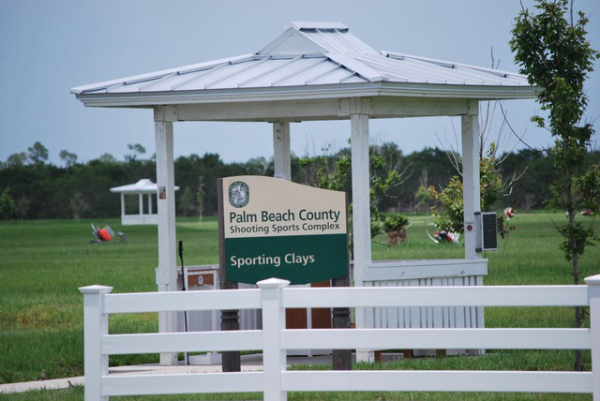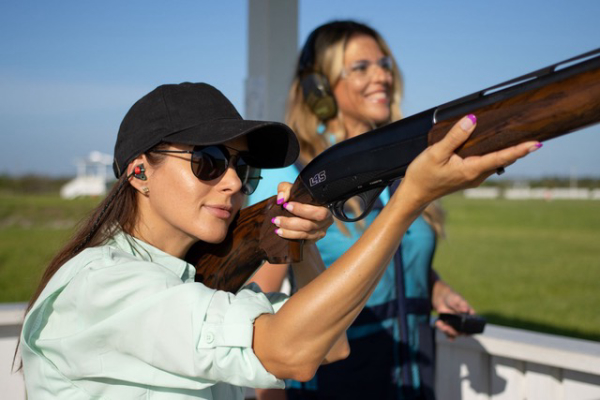Florida Shooting Range Courtesy of Pittman-Robertson Funding
By Craig Springer (Springer is with the USFWS, Wildlife and Sport Fish Restoration)
Trap, skeet, sporting clays—and soon, an archery park—made possible by excise taxes paid by industry
Necessity and opportunity coincided in Palm Beach, Florida. The need: Palm Beach is heavily developed and populated, and lacked a public target shooting range. Opportunity presented itself to build a new, state-of-the art recreational target range following land donations and funding from federal excise taxes paid by firearms, ammunition, and archery manufacturers via the Wildlife Restoration Act (Pittman-Robertson).

Palm Beach County Shooting Sports Complex opened in October 2022 following eight years of planning and phased-in construction. The outcome is an enviable public target range that serves a large swath of publics, from the causal target-shooter to the competitive athlete at the upper echelon—Olympians.
“Privately owned ranges are getting squeezed out to development in Florida,” said Bill Cline with the Florida Fish and Wildlife Conservation Commission. “The price and demand for land for homes and business eased out places for recreational target shooters to go.” Cline is the agency’s Section Leader for Hunter Safety and Public Shooting Ranges. It is in his purview to steer new range construction and operation and maintenance of the agency’s 11 public ranges. “Pittman-Robertson funding helps us fill those gaps and build new or enhance existing public ranges to meet the needs of the people of Florida and our visitors.”
According to Cline, a demographics study conducted by the Florida Fish and Wildlife Commission in 2013 revealed that more than 2.3 million people age 18 and older live within a 50-mile radius of the new Palm Beach range.
The demand exists for a range. Since opening, the Palm Beach complex gets about 300 visitor a day on weekends, fewer during the week, where they can partake in a variety of shooting sports, all supervised by trained range masters. Here’s a snapshot of the complex’s offerings:
Handgun ranges
The 42-position 25/50-meter and 30-position 10 meter/50-foot handgun ranges accommodate International Shooing Sports Federation and USA Shooting disciplines, and for shooters to practice their marksmanship skills.
Rifle ranges
The 6-position 300-yard rifle range and the 20-position 200-yard rifle range designed for experienced shooters. These feature electronically scored Kongsberg Target Systems. Shooters on the 20-position 100-yard rifle range can choose targets at either 50 or 100 yards to sight in their rifles and hone marksmanship skills.
American Trap
Six automated American trap fields allows shotgun shooters to test their skills from five different positions.
International Trap
Five automated fields offer international-style shotgun skeet and international trap, and four of the fields have covered firing lines.
Skeet
Nine skeet fields can be set to shoot either American or international skeet. American skeet fields have eight shotgun shooting stations and two trap houses. Seven of the stations are arranged in a half moon between the two trap houses and one station is directly between them. The high house, on the left side of the field, throws its targets from a trap 10 feet above the ground, and the low house target, on the right side, leaves the trap house just 3.5 feet from the ground.

Sporting Clays
It is like golf, but with a shotgun on an automated 15-station sporting clays course. Shooters move from station to station where they encounter situations that simulate the flight path of waterfowl, upland gamebirds, or a bounding rabbit.
The Palm Beach range complex adjoins the existing J.W. Corbett Wildlife Management Area that was also purchased by Pittman-Robertson funds in 1947. The excise taxes continue to fund the WMA’s operation and management. Visitors to the 93-square-mile WMA can watch wildlife, fish for bream in ponds, hunt wild turkey, waterfowl, and deer.
The shooting complex also affords classrooms to teach hunter education classes. “To be a hunter,” said Cline, “you have to be a shooter first. Teaching classes here gives students easy access for the live-fire portion of the hunter education course. They get a greater immersion into the safe and responsible handling of firearms, in person, rather on a computer.”
Those who like to shoot bows will enjoy knowing that a 3-D archery park is in the works as is an RV park that will accommodate competitive shooters traveling by coach, among others. Also on the near horizon is a 10,000 square foot administrative building that will support events large and small—local or international—that will positively affect the local economy.
Learn more the 850 public firearms and archery ranges across the U.S. at Partner with a Payer.






